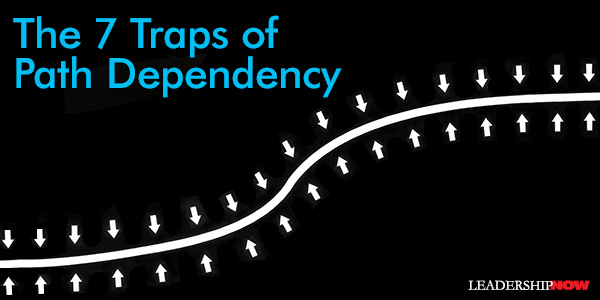 |
 |
10.07.24

The 7 Traps of Path Dependency
TREND HUNTER CEO Jeremy Gutsche says the most important trait we need for our fast-moving future is the ability to change. He wrote Create the Future + The Innovation Handbook: Tactics for Disruptive Thinking (two books in one) to help us. “We are more dependent on our past decisions than we like to admit. Once a path is set, we often walk down it blindly, failing to question why it was put there to begin with and whether a better path might exist.” Staying relevant doesn’t just happen. It takes work and knowing what we do to sabotage it. Once we get on a path we tend to stay there. It’s stable and comfortable. We have to disrupt ourselves or we overlook or ignore opportunities. We reduce our ability to do just that by falling into some or all of these seven traps. 1. The Subtlety of Opportunity Opportunities rarely look like the obvious, easy move. They usually look like challenges. Success often blinds you to opportunities. “Market leaders consistently miss out on great new ideas because they overestimate their market dominance.” And so, they easily dismiss new ideas. What to do? Gutshe offers some suggestions on how we can make ourselves more open to opportunities. Among them are, assume you are incorrect, reward and encourage dissent, study other markets and get outsiders to suggest ideas you might be missing. 2. Neurological Shortcuts Our brains are designed to be efficient. This can cause us to miss opportunities and resist change, especially in areas where we have expertise. This creates blind spots and limits our creativity. When you perform a task for the first time, your brain needs to figure out what you are trying to do. This results in your brain shooting a spark along a new neural pathway. Once you start practicing something over and over again, your brain decides to make it easier for you by paving a little pathway of myelin. Myelin is a white fatty tissue, and it guides your synapses, making you better and faster. As you master a skill, you start building a LOT of myelin. In fact, 40% of your brain is made up of myelin tissue. Practice creates myelin, which makes you smarter and faster, but it also makes you repetitive, consistent, and dismissive. What to do? Encourage play, ask questions, fund creative hobbies, and host weekly blue-sky meetings, and embrace the mindset of “no bad ideas.” 3. The Ease of Inaction Busyness can cause us to put off change. When we are busy, we prefer stability and simplicity. Our systems often provide the inertia to stay on the path and avoid change. “If you want to reduce your resistance to change, you need to clear the obstacles that block deep thought” and create a sense of urgency. “If you want change to happen, you must begin by igniting a sense of urgency and purpose.” What to do? Simplify the plan, put the customers first and force the discussion of competing alternatives. 4. Optionality The choices we make set us on a path. “We tend to make decisions that get short-term results, not realizing that certain choices can fix us to the path we are on and reduce our future potential. Optionality is about making decisions that increase our future choices.” What choice have you made that placed you in the position you are in today? What to do? Bring together people who would not otherwise interact, give people “permission slips” to fail, fuel audacity, escape your routine, push the limits, and set up a talent exchange to see other perspectives. 5. The Traps of Success Success has its dark side. It can make us complacent, repetitive, and defensive. “As we master any craft, we become loyal, consistent, and disciplined. But when something is new, we are curious, insatiable, and willing to destroy the status quo.” This is a tension—between farmer and hunter—that must be managed. Understand that:
What to do? Be curious, be willing to destroy old ways of doing things, recognize that your greatest strength creates your greatest weakness, ask outsiders for opinions, and simulate starting from scratch. 6. Linear Thinking “Unfortunately, our human brains are not designed for our exponentially evolving world. We understand that our world is changing, but we assume the next interval of change will be similar to the last. We have a very difficult time understanding the compounding impact of change.” Change is a given. What we need to prepare for it the acceleration of change. What to do? Track the amount of change in your market, brainstorm your Super Future, prepare scenarios to disrupt or avoid being disrupted, assume that far-off predictions will happen sooner than you think, compare the present to the past to predict the future. 7. Discomfort vs. Breakthrough A new idea that takes us down a different path requires change. And that makes us feel awkward. We have to learn to be comfortable with discomfort. Getting outside your comfort zone is—well, uncomfortable. What ideas have you ignored that could have put you on a different, better path? To realize your potential, look past the awkwardness of new ideas, train your brain to be more creative, take action, open up your future options, and recognize the blinding power of your own expertise. Track trends in your market, internalize the pace of change, and push your comfort zone—because you are capable of more than you think. 
Posted by Michael McKinney at 09:18 AM
|
BUILD YOUR KNOWLEDGE
 

How to Do Your Start-Up Right STRAIGHT TALK FOR START-UPS 
Grow Your Leadership Skills NEW AND UPCOMING LEADERSHIP BOOKS 
Leadership Minute BITE-SIZE CONCEPTS YOU CAN CHEW ON 
Classic Leadership Books BOOKS TO READ BEFORE YOU LEAD |